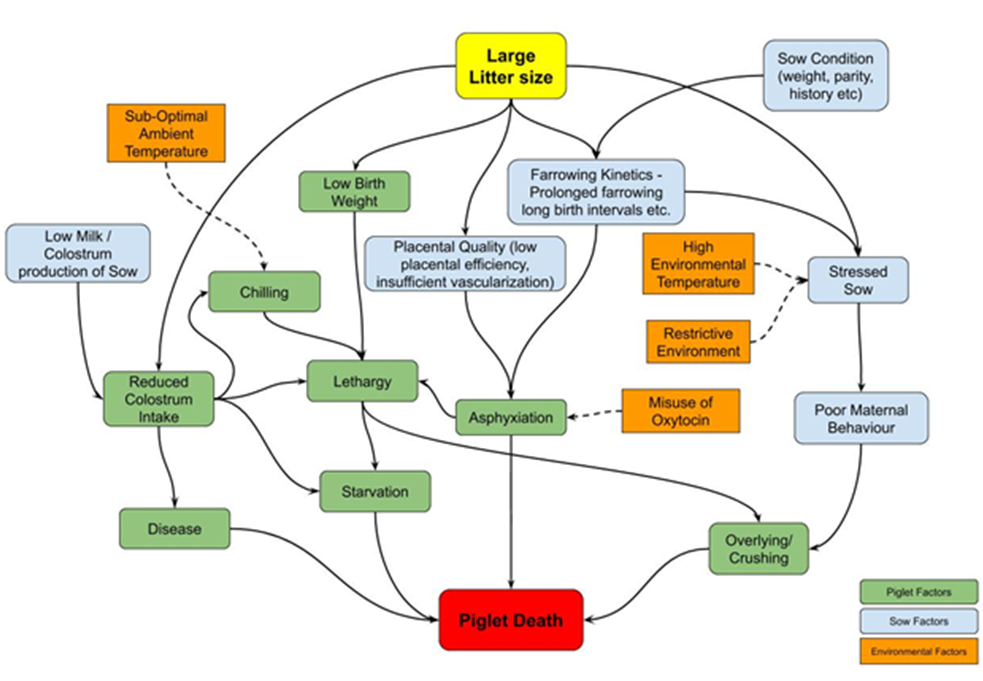



Factors affecting preweaning piglet mortality: part 1
Pigs are polytochous animals, which means they produce multiple piglets in one farrowing. This evolutionary strategy is called “parental optimism” and it allows the dam to produce more offspring than what is required for its replacement (Mock and Forbes. 1995).In nature, this strategy allows the mother to take advantage of the unpredictable environmental conditions at the time of lactation. I.e. they produce more young offspring’s just in case if the environmental largess makes them affordable. This, in turn, demands an energetic investment from the dam to produce additional offspring. In this situation, she needs to optimize the available energy investment per piglet, such that any offspring that cannot be raised should die as early as possible without affecting the survival of other littermates. This is achieved by disproportionate allocation of resources which in turn results in intense sibling rivalry (like limited uterine space, limited availability of colostrum, advancement of dentition-needle teeth etc.) and lower survival chances for weaker piglets (Edwards and Baxter, 2015). In other words, the mother should aim high, but should be ready to fall back to a smaller family size when nature demands. This evolutionary adaptation explains in part why we have large pre-weaning mortality at a very early stage in life.
As litter size has increased significantly, these challenges have been magnified in modern pig husbandry. This, along with the selection for increased lean growth and decline in body fat has resulted in piglets with reduced physiological maturity at birth, which in turn has resulted in reduced vigor and thermoregulatory ability of newborn piglets (Herpin et al. 1993).
Pre-weaning mortality is a major economic cost and welfare concern in commercial pig production. Various review articles have shown that the pre-weaning mortality in commercial swine herds ranges between 10 to 20 percent, and majority of these deaths happen within 72 hours after birth. Pre-weaning mortality is an opportunity cost for the producer, meaning it is the lost opportunity to make a profit.
For example, on a 500-sow farrow-to-finish operation, with 2.3 litter per sow per year, each one additional pig weaned per litter would result in an added profit of $23,000/year at a rate of $20 per weaned pig (500*2.3*1*20). This profit comes at a minimal additional cost as the marginal cost for raising this additional piglet till weaning is very small.
Multiple studies have shown that the most common reasons for preweaning mortality are crushing, low viability, and starvation. However, it is difficult to separate these reasons to look at the detailed factors for each reason. For example, a piglet might have died by crushing, but this might have been a culmination of the interaction of various factors like low birth weight, starvation, and hypothermia. Because of this complex nature of pre-weaning mortality, extreme care should be taken while analyzing pre-weaning mortality data. Some of the predisposing causes of pre-weaning mortality and their complex interactions are illustrated in Figure 1 below. Obviously solving pre-weaning mortality is not as straightforward as it might first appear.

© Adopted from Edwards and Baxter, 2015
To address the topic of pre-weaning mortality holistically we need to understand the cause of different types of piglet mortality along with the factors that exacerbate this. In this series of three articles, we will discuss the various factors that cause pre-weaning mortality and the ways to decrease it. This article discusses why pre-weaning mortality as a multifactorial complex and the impact factors can be broadly divided into (a) Sow factors (b) piglet factors and (c) environmental factors. These factors will be discussed in detail in the second article. Pre-weaning mortality does have a genetic component, and in the third article, we will discuss the genetic selection strategies that Genesus has adopted to decrease pre-weaning mortality
| References | ||||
|---|---|---|---|---|
| Edwards, Sandra & Baxter, Emma. | ||||
| (2015) | Piglet mortality: Causes and prevention.. The Gestating and Lactating Sow. | 253-278 | ||
| Mock, D.W. and Forbes, L.S., | ||||
| (1995) | The evolution of parental optimism.. Trends in Ecology & Evolution 1 | 0: 130-134. | ||
| Herpin, P., Le Dividich, J. and Amaral, N., | ||||
| (1993) | Effect of selection for lean tissue-growth on body-composition and physiological-state of the pig at birth.. Journal of Animal Science 7 | 1: 2645-2653 |









